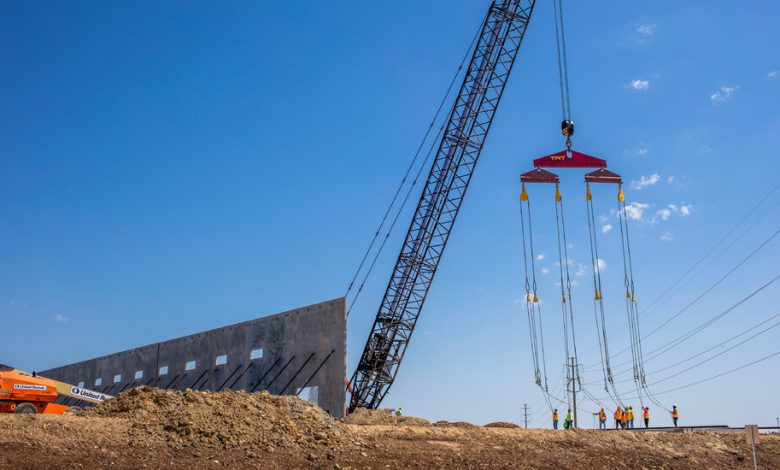Need for Speed Spurs Demand for Move-In-Ready Buildings

[ad_1]
WEST CHESTER, Ohio — Suburban spillover has long been chewing away at the bucolic countryside around Cincinnati. Twenty-five years ago, the growth was powered by affordable housing and award-winning schools. But, as the economy has changed, so have the demands for space.
Part of West Chester, a town about 18 miles north of Cincinnati, is bound by three interstate highways, which has made it a coveted logistics hub, and developers have taken note: Not long ago, seven acres of farmland there were targeted for repurposing by NorthPoint Development.
A mere 18 months after the project was proposed, the first tenants began moving into the 1.8-million-square-foot West Chester Trade Center, which had risen on those acres and brought medical businesses and light manufacturing with it. General Electric opened a 3-D printing facility with jobs that averaged over $100,000 in annual salary, said David Fehr, the director of the Butler County Department of Economic Development.
What makes the West Chester Trade Center noteworthy is that it was built on speculation, meaning that it was constructed without a guaranteed tenant. Typically, amenities for spec buildings are sparse, but most have loading docks, ample height clearance and parking lots.
The need for speed makes spec buildings increasingly attractive to developers and economic officials, who say the trend is accelerating.
“We started seeing a big push five years ago, and the folks that we talk to say it is simply that these companies are expanding at such a rate that they won’t have the time or expertise to build a building from scratch,” Mr. Fehr said.
It used to be that a city would open an industrial park with great fanfare, promoting its utilities and roads, and that companies would do the rest. But that process, known as building to suit, is too slow for many businesses in the increasingly volatile supply chain ecosystem.
It isn’t just large markets getting in on the spec building boom. Even small towns are putting their muscle behind such construction.
In Whiteland, Ind., a town of about 4,400 people, local leaders courted an Atlanta firm to invest $70 million to build two spec buildings, one 500,000 square feet and the other 1.1 million square feet. The buildings are scheduled for completion in 2023 and 2024.
There are risks with spec buildings, like fickle macroeconomic conditions and acute local ones, which can dry up demand in a hurry, leaving a municipality and a developer holding an empty building.
For now, “it doesn’t feel like that party will end any time soon,” said Andrew Hunt, the Vieth Director for the Center for Real Estate at Marquette University. It comes down to supply and demand, he said. Vacancy rates are so low, and so many tenants are looking for space that, even 30 months out, the building will be filled.
“Historically, spec buildings have been risky, but in a market environment like we are in now, where there is a race to get goods to people faster and to manufacture more things, the flexibility of the spec space becomes an asset, not a liability,” Mr. Hunt said. He added that industrial space vacancy was less than 5 percent nationally.
The insatiable appetite for move-in-ready buildings has been powered by e-commerce, which was significantly enhanced during the pandemic when many manufacturers brought overseas facilities back to the United States, he said.
A significant risk, though, is inflation. Construction and labor costs are going up, causing developers to raise rents. Mr. Hunt estimates it costs developers 40 percent more to construct an average spec warehouse this year than it did last year.
But some industry watchers say inflation and supply chain issues are contributing to the spec building boom rather than hindering it.
Developers like to build as soon as they can because waiting can drive up the cost, said Gary Roden, the vice president of design-build business development at TDIndustries, a construction firm in Dallas. “Texas has a great inflow of businesses, which helps the demand and causes lenders to be more bullish,” he said.
Most spec buildings are flexible. Often, about 5 percent of the space is set aside for offices, Mr. Hunt said, but that can vary by market.
In Austin, Texas, for example, up to 10 percent of a spec building is often office space, whereas San Antonio demands less.
“Uses of spec buildings in San Antonio are more distribution based,” said Joe Iannacone, a senior vice president at Titan Development, which is in the middle of a two-million-square-foot spec development in Hutto, Texas, just outside Austin.
The thought of recession is always in the back of his mind, Mr. Iannacone said, but market conditions, especially in the Southwest, are showing no signs of changing.
“All of these suppliers need space, and there isn’t the space right now,” he said. Titan typically picks sites in smaller municipalities where zoning restrictions are generally less onerous.
NorthPoint Development, one of the nation’s most prominent players in spec development, has a 40-million-square-foot project underway in Joliet, Ill., Locals objected to the size, but the City Council gave NorthPoint the greenlight this spring.
The market will support the development, said Brent Miles, NorthPoint’s chief marketing officer. “There is a tremendous amount of demand, and I don’t see it ending,” he said. Seventy-five percent of NorthPoint’s leasing is in speculative development.
He added that most developers based their decisions on three criteria: location, infrastructure and labor availability.
Spec buildings are more than shell warehouses. Multistory buildings are becoming more common, primarily in coastal areas where land is scarce. Some builders are even taking chances on specialized specs, hoping to capitalize on a growing demand in the biomedical sector.
“The need for lab space far exceeds the current supply,” said Scott Cooper, a vice president and division manager at Brasfield & Gorrie, one of the largest privately held construction firms in the United States. “This has led many of our clients to develop lab buildings on spec to give their tenants a jump-start in their race to be first to market.”
Biomedical clients are confident they will be able to lease the space as quickly as it can be built, Mr. Cooper said, adding that demand for lab space in North Carolina’s Research Triangle area, for example, has surged.
“With vacancies as low as they are, it would take a significant decrease in demand for life science space to shift away from speculative building in these key markets,” he said.
[ad_2]
Source link






